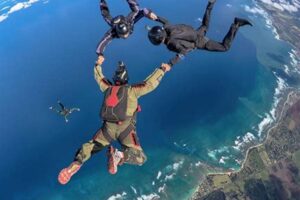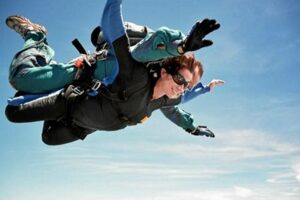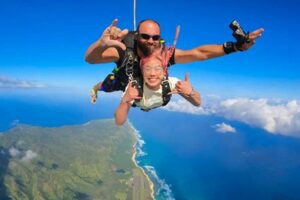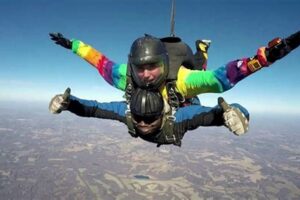Table of Contents
Wind Tunnel Skydiving: A Thrilling Simulation of Freefall
Wind tunnel skydiving, a captivating indoor activity that simulates the exhilarating sensation of freefall skydiving, offers a unique and controlled environment for individuals to experience the thrill of skydiving without the risks associated with jumping from an aircraft. This innovative concept involves a large vertical wind tunnel that generates a powerful upward airflow, allowing participants to float and maneuver in a safe and controlled setting.
The allure of wind tunnel skydiving lies in its accessibility, allowing individuals of all skill levels to experience the exhilaration of skydiving without the extensive training and potential dangers associated with traditional skydiving. Additionally, wind tunnel skydiving provides a platform for skydivers to hone their skills and techniques in a safe and controlled environment before attempting outdoor skydives.
The origins of wind tunnel skydiving can be traced back to the early 1960s when the concept was first explored by engineers and scientists seeking to develop a training tool for skydivers. Over the years, wind tunnel technology has advanced significantly, leading to the development of state-of-the-art facilities that offer a realistic and immersive skydiving experience.
As we delve deeper into the world of wind tunnel skydiving, we will explore the various techniques involved, the safety precautions that ensure a controlled and enjoyable experience, and the benefits of this exhilarating activity for both recreational enthusiasts and professional skydivers.
Wind Tunnel Skydiving
Wind tunnel skydiving has gained immense popularity as a thrilling and accessible way to experience the exhilaration of freefall without the risks associated with traditional skydiving. This indoor activity offers a controlled environment for individuals to explore various aspects of skydiving, from learning basic techniques to honing advanced skills.
- Simulation: Accurately recreates the sensation of freefall skydiving.
- Safety: Eliminates the risks associated with jumping from an aircraft.
- Control: Allows participants to adjust wind speed and height for a personalized experience.
- Training: Provides a platform for skydivers to practice techniques and improve skills.
- Accessibility: Open to individuals of all skill levels and physical abilities.
- Instruction: Qualified instructors guide participants through the experience.
- Technique: Participants learn proper body position, hand and leg movements, and control techniques.
- Progression: Skydivers can gradually increase wind speed and height as they gain confidence.
- Enjoyment: Offers a unique and exhilarating form of entertainment.
These key aspects of wind tunnel skydiving contribute to its growing popularity as a safe, accessible, and enjoyable activity for individuals seeking the thrill of skydiving without the associated risks. Whether for recreational purposes or professional training, wind tunnel skydiving provides a controlled environment for participants to experience the exhilaration of freefall and develop their skydiving skills.
Simulation
When it comes to simulating the exhilarating experience of freefall skydiving, wind tunnels offer an incredibly accurate and controlled environment. This meticulously crafted simulation encompasses various factors that work in harmony to mimic the true sensation of skydiving.
- Vertical Wind Tunnel: A large cylindrical chamber generates a powerful upward airflow, creating a stable and consistent environment for participants to experience the feeling of freefall.
- Wind Speed Control: Adjustable wind speeds allow participants to customize their experience, whether they are beginners seeking a gentle breeze or experienced skydivers craving the thrill of high-speed winds.
- Body Position and Movement: Participants can practice proper body positioning, hand and leg movements, and control techniques under the guidance of experienced instructors, replicating the maneuvers performed during actual skydives.
- Visual and Auditory Cues: Some wind tunnels incorporate visual and auditory elements to further enhance the simulation, such as projected skydiving scenarios and realistic wind noises, immersing participants in a lifelike skydiving experience.
By combining these elements, wind tunnel skydiving provides an incredibly accurate simulation of freefall skydiving, allowing participants to experience the thrill, exhilaration, and challenges of the sport in a safe and controlled environment. It serves as an ideal training ground for aspiring skydivers to develop their skills and techniques before taking to the skies, and also offers a unique and immersive experience for recreational enthusiasts seeking the adrenaline rush of skydiving without the associated risks.
Safety
The fundamental advantage of wind tunnel skydiving lies in its ability to eliminate the inherent risks associated with jumping from an aircraft. Traditional skydiving involves a multitude of potential hazards, including equipment malfunctions, human error, weather conditions, and the inherent dangers of freefall itself. Wind tunnel skydiving, on the other hand, mitigates these risks through its controlled and closely monitored environment.
Cause and Effect: The elimination of risks in wind tunnel skydiving is a direct result of its unique setup and stringent safety protocols. The enclosed nature of the wind tunnel eliminates the possibility of midair collisions, while the controlled airflow ensures a stable and predictable environment for participants. Additionally, wind tunnel instructors are extensively trained to provide real-time guidance and assistance, ensuring the safety of participants throughout the experience.
Critical Component: Safety is not merely an added feature in wind tunnel skydiving; it is an integral and indispensable component that defines the very nature of the activity. Without the elimination of risks, wind tunnel skydiving would not exist as a viable and accessible sport. It is this focus on safety that has allowed wind tunnel skydiving to gain widespread popularity among individuals of all ages and skill levels.
Real-Life Examples: The safety record of wind tunnel skydiving speaks for itself. Since its inception, there have been virtually no reported accidents or injuries resulting from the activity. This impeccable safety record is a testament to the effectiveness of the safety measures implemented in wind tunnel facilities worldwide.
Practical Applications: The elimination of risks in wind tunnel skydiving has far-reaching practical applications. It allows individuals to experience the thrill of skydiving without the associated fears and anxieties. This opens up the sport to a broader audience, including those who may have been hesitant to try traditional skydiving due to safety concerns. Additionally, wind tunnel skydiving provides a safe and controlled environment for skydivers to train and hone their skills, improving their technique and confidence before attempting outdoor skydives.
Summary: Wi
nd tunnel skydiving’s elimination of risks is not just a marketing tagline; it is a fundamental aspect that sets it apart from traditional skydiving. This focus on safety has made wind tunnel skydiving an accessible and enjoyable activity for individuals of all backgrounds, while also providing a valuable training platform for experienced skydivers. Its success in eliminating risks has revolutionized the sport of skydiving, making it safer and more accessible than ever before.
Control
In the realm of wind tunnel skydiving, control takes center stage, empowering participants to tailor their experience to their unique preferences and skill level. This unparalleled level of control encompasses various aspects, ranging from adjusting wind speed and height to customizing the overall skydiving simulation.
- Adjustable Wind Speed: Participants can fine-tune the wind speed to suit their comfort level and desired intensity. Whether they seek a gentle breeze or the exhilarating rush of high-speed winds, the adjustable wind speed ensures a personalized and immersive experience.
- Variable Height: The ability to adjust the height of the flight chamber allows participants to gradually acclimate to the sensation of freefall. Beginners can start at a lower height and progressively increase it as they gain confidence and proficiency.
- Customized Flight Experience: Wind tunnel facilities offer a range of flight experiences, catering to different skill levels and preferences. These experiences may include simulated freefall, formation flying, and aerobatic maneuvers, allowing participants to tailor their session to their specific interests and goals.
- Real-Time Guidance: Experienced instructors provide real-time guidance and feedback, helping participants refine their technique, overcome challenges, and progress at their own pace.
The ability to control various aspects of the wind tunnel skydiving experience enhances safety, increases enjoyment, and accelerates learning. It empowers participants to take charge of their experience, fostering a sense of confidence and control that translates into a truly personalized and unforgettable skydiving adventure.
Training
Within the realm of wind tunnel skydiving, training plays a pivotal role, providing a controlled and immersive environment for skydivers to hone their skills, enhance their technique, and build confidence before taking to the skies. This training aspect is not merely an add-on but an integral component of wind tunnel skydiving, enabling participants to develop the necessary expertise for safe and enjoyable skydiving experiences.
Cause and Effect: The causal relationship between training and wind tunnel skydiving is undeniable. Without proper training, individuals would lack the knowledge, skills, and techniques required to safely navigate the wind tunnel environment. Training provides a structured and progressive approach, allowing participants to gradually develop their proficiency and master the art of wind tunnel skydiving.
Critical Component: Training is not just a desirable aspect of wind tunnel skydiving; it is a critical component that ensures the safety and enjoyment of participants. By providing a dedicated space for learning and practice, training minimizes the risks associated with skydiving and maximizes the potential for a positive and memorable experience.
Real-Life Examples: Numerous examples illustrate the effectiveness of training in wind tunnel skydiving. Many skydivers credit their successful transition to outdoor skydiving to the skills and confidence they gained through wind tunnel training. Training enables skydivers to practice various maneuvers, troubleshoot potential challenges, and refine their technique in a controlled setting before attempting them in the open sky.
Practical Applications: The practical applications of training in wind tunnel skydiving are far-reaching. It enables skydivers to progress more quickly and safely through their training, reducing the time and resources required to become proficient. Additionally, training helps skydivers identify and correct any technical flaws in their technique, leading to improved performance and increased enjoyment during actual skydives.
Conclusion: Training is an indispensable aspect of wind tunnel skydiving, providing a platform for skydivers to practice techniques, improve skills, and build confidence in a controlled environment. It is not just a preparatory step but an ongoing process that enables skydivers to continuously refine their skills and enhance their skydiving experience. The emphasis on training in wind tunnel skydiving underscores its importance as a critical component of the sport, ensuring the safety, enjoyment, and progression of all participants.
Accessibility
Wind tunnel skydiving stands as a beacon of accessibility, welcoming individuals of all skill levels and physical abilities to experience the exhilaration of freefall skydiving in a safe and controlled environment. This revolutionary aspect of wind tunnel skydiving has transformed the sport, making it an inclusive activity that transcends traditional barriers.
Cause and Effect: The accessibility of wind tunnel skydiving is directly attributed to its unique setup and meticulously designed safety protocols. Unlike traditional skydiving, which requires extensive training and carries inherent risks, wind tunnel skydiving eliminates these barriers. Participants are securely harnessed within the wind tunnel, eliminating the fear of falling. Additionally, the controlled airflow allows for a gradual and customizable experience, catering to individuals of varying skill levels and physical abilities.
Critical Component: Accessibility is not merely an added feature in wind tunnel skydiving; it is a fundamental component that defines its very nature. Without accessibility, wind tunnel skydiving would remain an exclusive activity reserved for a select few. By breaking down traditional barriers, wind tunnel skydiving opens up a world of possibilities for individuals who may have never considered skydiving due to physical limitations or lack of experience.
Real-Life Examples: The impact of accessibility in wind tunnel skydiving is evident in the diverse range of participants who take to the wind. From wheelchair users to individuals with disabilities, wind tunnel skydiving has empowered people from all walks of life to experience the thrill of flight. Notable examples include Bethany Hamilton, a professional surfer who lost her arm in a shark attack, and Mark Sutton, a blind skydiver who has completed over 1,000 jumps.
Practical Applications: The accessibility of wind tunnel skydiving extends beyond its inclusivity. It serves as a valuable training tool for skydivers of all levels. Beginners can learn the basics of skydiving in a safe and controlled environment before transitioning to outdoor skydives. Experienced skydivers can hone their skills and practice new maneuvers without the risks associated with outdoor skydiving.
Summary of Insights: Wind tunnel skydiving’s accessibility has revolutionized the sport, making it an inclusive activity that caters to individuals of all skill levels and physical abilities. This accessibility is not only a commendable feature but a critical component that has broadened the appeal of skydiving and made it a truly accessible sport. The real-life examples and practical applications underscore the transformative impact of accessibility, demonstrating how wind tunnel skydiving has broken down barriers and empowered individuals to experience the exhilaration of freefall in a safe and controlled environment.
Instruction
In the exhilarating realm of wind tunnel skydiving, the role of qualified instructors takes center stage, ensuring a safe
, enjoyable, and educational experience for participants of all skill levels. These highly trained professionals provide invaluable guidance, expert coaching, and personalized instruction, enabling participants to navigate the wind tunnel environment with confidence and ease.
- Pre-Flight Briefing:
Prior to entering the wind tunnel, instructors conduct a comprehensive briefing, explaining safety procedures, body positioning, hand and leg movements, and communication signals. This thorough preparation instills confidence and ensures participants fully understand what to expect during their flight. - In-Flight Guidance:
Throughout the wind tunnel experience, instructors provide real-time guidance via hand signals and verbal communication. They monitor participants’ body position, speed, and altitude, offering corrective feedback and encouragement. This constant support helps participants refine their technique and progress safely. - Customized Instruction:
Instructors tailor their teaching approach to suit the individual needs and goals of each participant. Whether it’s a first-time flyer seeking a gentle introduction or an experienced skydiver looking to perfect their skills, instructors adapt their instruction to ensure participants achieve their desired outcomes. - Emergency Procedures:
Instructors are trained to handle any potential emergency situation that may arise during a wind tunnel flight. They are equipped with the knowledge and skills to respond quickly and effectively, ensuring the safety of participants at all times.
The presence of qualified instructors is not only crucial for safety but also instrumental in maximizing the enjoyment and learning potential of the wind tunnel skydiving experience. Their expertise and guidance empower participants to push their limits, overcome challenges, and achieve a sense of accomplishment. Whether it’s a recreational thrill-seeker or an aspiring skydiver, the instruction provided by qualified instructors is an indispensable element that elevates the wind tunnel skydiving experience to new heights.
Technique
In the realm of wind tunnel skydiving, technique plays a pivotal role in ensuring a safe, enjoyable, and successful experience. Participants are meticulously taught proper body positioning, hand and leg movements, and control techniques, which are essential for navigating the wind tunnel environment and achieving a stable and controlled flight.
Cause and Effect: The relationship between technique and wind tunnel skydiving is one of cause and effect. Mastering proper technique directly influences the quality and safety of the wind tunnel experience. Correct body positioning, hand and leg movements, and control techniques enable participants to maintain stability, control their speed and altitude, and perform various maneuvers safely and effectively.
Critical Component: Technique is an indispensable component of wind tunnel skydiving. Without a solid foundation in technique, participants would struggle to control their flight, increasing the risk of accidents and injuries. Proper technique empowers participants to fly smoothly, confidently, and with greater enjoyment.
Real-Life Examples: The importance of technique in wind tunnel skydiving is evident in the experiences of both recreational flyers and professional skydivers. Recreational flyers who receive thorough instruction and practice proper technique often report feeling more confident and in control during their flights, leading to a more enjoyable experience. Professional skydivers, on the other hand, rely on impeccable technique to perform complex maneuvers and achieve high levels of performance.
Practical Applications: Understanding the connection between technique and wind tunnel skydiving has several practical applications. Firstly, it highlights the importance of qualified instruction. Experienced instructors can provide expert guidance and ensure that participants develop proper technique from the start. Secondly, it emphasizes the value of regular practice. Consistent practice allows participants to refine their technique, gain confidence, and progress to more advanced maneuvers.
Summary of Insights: In wind tunnel skydiving, technique is paramount. Proper body positioning, hand and leg movements, and control techniques are essential for a safe, enjoyable, and successful experience. Without a solid foundation in technique, participants would face increased risks and diminished enjoyment. Real-life examples and practical applications underscore the importance of qualified instruction and regular practice in developing proper technique. Ultimately, mastering technique is the key to unlocking the full potential of wind tunnel skydiving.
Progression
In the realm of wind tunnel skydiving, progression plays a pivotal role, enabling participants to gradually enhance their skills, confidence, and overall experience. This carefully structured approach allows individuals to start at a comfortable level and progress at their own pace, building a solid foundation before taking on more challenging maneuvers.
- Wind tunnel skydiving instructors employ a systematic approach, introducing participants to basic techniques and gradually increasing the complexity of maneuvers as they demonstrate proficiency.
- Progression is tailored to each individual’s needs and goals. Instructors assess participants’ skills and adjust the training plan accordingly, ensuring a personalized and enjoyable experience.
- As participants progress through the training program, they develop a sense of confidence and mastery. This newfound confidence empowers them to push their limits and attempt more challenging maneuvers.
- The gradual progression in wind tunnel skydiving prioritizes safety. Instructors ensure that participants are adequately prepared before moving on to more advanced maneuvers, minimizing the risk of accidents and injuries.
The concept of progression in wind tunnel skydiving mirrors the approach taken in other skill-based activities. Just as musicians start with simple scales and progress to complex pieces, wind tunnel skydivers begin with fundamental techniques and gradually work their way up to more intricate maneuvers. This structured approach ensures that participants develop a strong foundation, enabling them to safely and confidently explore the full potential of the sport.
Enjoyment
In the realm of indoor skydiving, the pursuit of enjoyment takes center stage, offering participants a thrilling and captivating recreational experience. Wind tunnel skydiving stands out as a unique and exhilarating form of entertainment that caters to individuals seeking an adrenaline rush, a sense of freedom, and an escape from the ordinary.
- Simulated Freefall:
Participants experience the exhilarating sensation of freefall skydiving in a safe and controlled environment, providing a taste of the thrill without the risks associated with jumping from an aircraft. - Physical Challenge:
Wind tunnel skydiving requires participants to engage their entire body, promoting physical fitness and coordination. The challenge of controlling one’s body position and movements in the wind tunnel adds an extra layer of excitement and satisfaction. - Social Bonding:
Wind tunnel skydiving is often enjoyed as a group activity, fostering camaraderie and shared experiences. The shared thrill of flying together creates a sense of unity and connection among participants. - Accessible Thrill:
Unlike traditional skydiving, wind tunnel skydiving is accessible to a wider range of individuals, including those with physical limitations or a fear of heights. This accessibility ope
ns up the experience to a diverse audience, allowing more people to enjoy the exhilaration of skydiving.
The enjoyment derived from wind tunnel skydiving extends beyond the immediate experience. The sense of accomplishment, the memories created, and the stories shared contribute to the overall entertainment value of the activity. Whether it’s a one-time adventure or a regular hobby, wind tunnel skydiving offers a unique and exhilarating form of entertainment that captivates and delights participants of all ages and backgrounds.
Frequently Asked Questions
This section addresses common inquiries and clarifies various aspects of wind tunnel skydiving, providing essential information for those seeking to experience this exhilarating activity.
Question 1: What is the minimum age requirement for wind tunnel skydiving?
The minimum age requirement varies depending on the wind tunnel facility, but it typically ranges from 3 to 4 years old. Some facilities may have stricter requirements, so it’s best to check with the specific facility you plan to visit.
Question 2: Is wind tunnel skydiving safe?
Yes, wind tunnel skydiving is a very safe activity. The wind tunnel is closely monitored by trained instructors who ensure that all safety precautions are followed. Participants are provided with comprehensive training before they enter the wind tunnel, and they are securely harnessed throughout the experience.
Question 3: What should I wear for wind tunnel skydiving?
Most wind tunnel facilities provide flight suits and helmets, but it’s a good idea to wear comfortable clothing that you can move around easily in. Avoid loose clothing or jewelry that could get caught in the wind. You may also want to wear sneakers or other closed-toe shoes.
Question 4: Can I do flips and tricks in the wind tunnel?
The ability to perform flips and tricks in the wind tunnel depends on your skill level and experience. Beginners will typically start with basic maneuvers, such as maintaining a stable body position and controlling their speed. As you progress, you can learn more advanced maneuvers, such as flips and spins. Your instructor will provide guidance and ensure that you are ready before attempting any advanced maneuvers.
Question 5: How long does a wind tunnel skydiving session typically last?
The duration of a wind tunnel skydiving session varies, but it typically ranges from 1 to 3 minutes. This may seem like a short amount of time, but it’s actually quite intense. Most people find that they are exhausted after a few minutes of flying.
Question 6: How much does wind tunnel skydiving cost?
The cost of wind tunnel skydiving varies depending on the facility, the duration of the session, and any additional services or packages you choose. Generally, you can expect to pay between $50 and $150 for a single session.
These FAQs provide a glimpse into the world of wind tunnel skydiving, addressing common concerns and offering practical information for those considering this exciting activity. As we delve deeper into the topic, we will explore the various techniques and skills involved in wind tunnel skydiving, the benefits it offers, and the factors to consider when choosing a wind tunnel facility.
Transition: Delving into the Techniques and Skills of Wind Tunnel Skydiving
Wind Tunnel Skydiving Tips for a Thrilling Experience
To ensure a safe, enjoyable, and exhilarating wind tunnel skydiving experience, here are some valuable tips to keep in mind:
Tip 1: Choose a Reputable Facility:
Conduct thorough research to select a reputable and experienced wind tunnel skydiving facility with a proven safety record and qualified instructors.
Tip 2: Listen Attentively to Instructions:
Pay close attention to the pre-flight briefing provided by the instructors. Understand the safety procedures, body positioning techniques, and communication signals to ensure a smooth and controlled flight.
Tip 3: Wear Comfortable Clothing:
Choose comfortable and form-fitting clothing that allows for ease of movement. Avoid loose clothing or accessories that could get caught in the wind.
Tip 4: Communicate Effectively:
Maintain clear and effective communication with your instructor throughout the experience. Use the designated hand signals or verbal cues to indicate any discomfort or request assistance.
Tip 5: Relax and Enjoy the Experience:
Remember to relax and enjoy the exhilarating sensation of flying. Trust the expertise of your instructor and focus on maintaining a stable body position.
Tip 6: Don’t Be Afraid to Ask Questions:
If you have any doubts or concerns, don’t hesitate to ask your instructor questions before and during the flight. Clarifying any uncertainties will enhance your confidence and overall experience.
Tip 7: Gradually Progress to Advanced Maneuvers:
Start with basic body positioning and control techniques. As you gain confidence and proficiency, gradually progress to more advanced maneuvers under the guidance of your instructor.
Tip 8: Consider Group Sessions for Added Fun:
Wind tunnel skydiving can be an even more thrilling and memorable experience when shared with friends or family. Consider booking a group session to create lasting memories together.
Remember, these tips are designed to optimize your wind tunnel skydiving experience, ensuring safety, enjoyment, and a sense of accomplishment. By following these guidelines and trusting the expertise of your instructors, you can unlock the full potential of this exhilarating activity.
Transition to the Conclusion: As you embark on your wind tunnel skydiving adventure, embrace the challenge, push your limits, and create unforgettable memories. Whether you’re a thrill-seeker or simply looking for a unique and exhilarating experience, wind tunnel skydiving offers a safe and controlled environment to experience the exhilaration of freefall without the risks associated with traditional skydiving.
Conclusion
Our exploration of wind tunnel skydiving unveils a captivating realm of exhilarating experiences, meticulously designed for safety, accessibility, and pure enjoyment. This unique activity has revolutionized the sport of skydiving, offering a controlled environment to simulate freefall without the risks associated with jumping from an aircraft.
As we reflect on the key insights gained throughout this article, three main points emerge:
- Safety and Control: Wind tunnel skydiving prioritizes safety through adjustable wind speeds, variable heights, and comprehensive training. Participants are securely harnessed, eliminating the fear of falling and empowering them to take calculated risks.
- Technique and Progression: Mastering proper body positioning, hand and leg movements, and control techniques is crucial for a successful wind tunnel skydiving experience. Instructors provide tailored instruction, allowing participants to progress gradually and safely through various maneuvers.
- Enjoyment and Accessibility: Wind tunnel skydiving offers a thrilling and entertaining activity suitable for individuals of all skill levels and physical abilities. Its accessibility breaks down traditional barriers, making it an inclusive sport that welcomes everyone to experience the exhilaration of freefall.
As we conclude our journey into the world of wind tunnel skydiving, we are left with a profound appreciation for its ability to blend safety, technique, and enjoyment into a truly exhilarating experience. Whether you’re a thrill-seeker looking for an adrenaline rush or an aspiring skydiver seeking a controlled environ
ment to hone your skills, wind tunnel skydiving offers a unique and unforgettable adventure.







